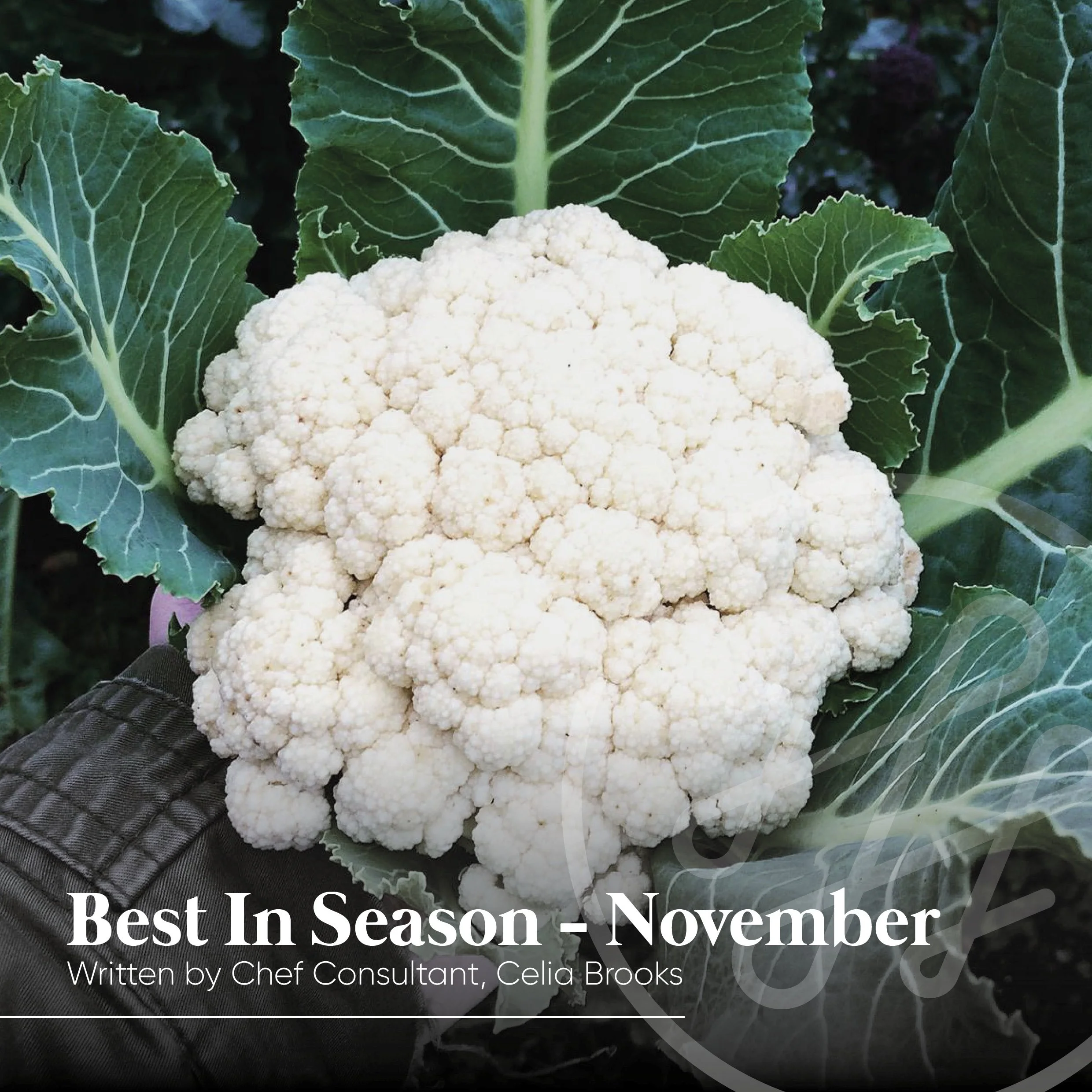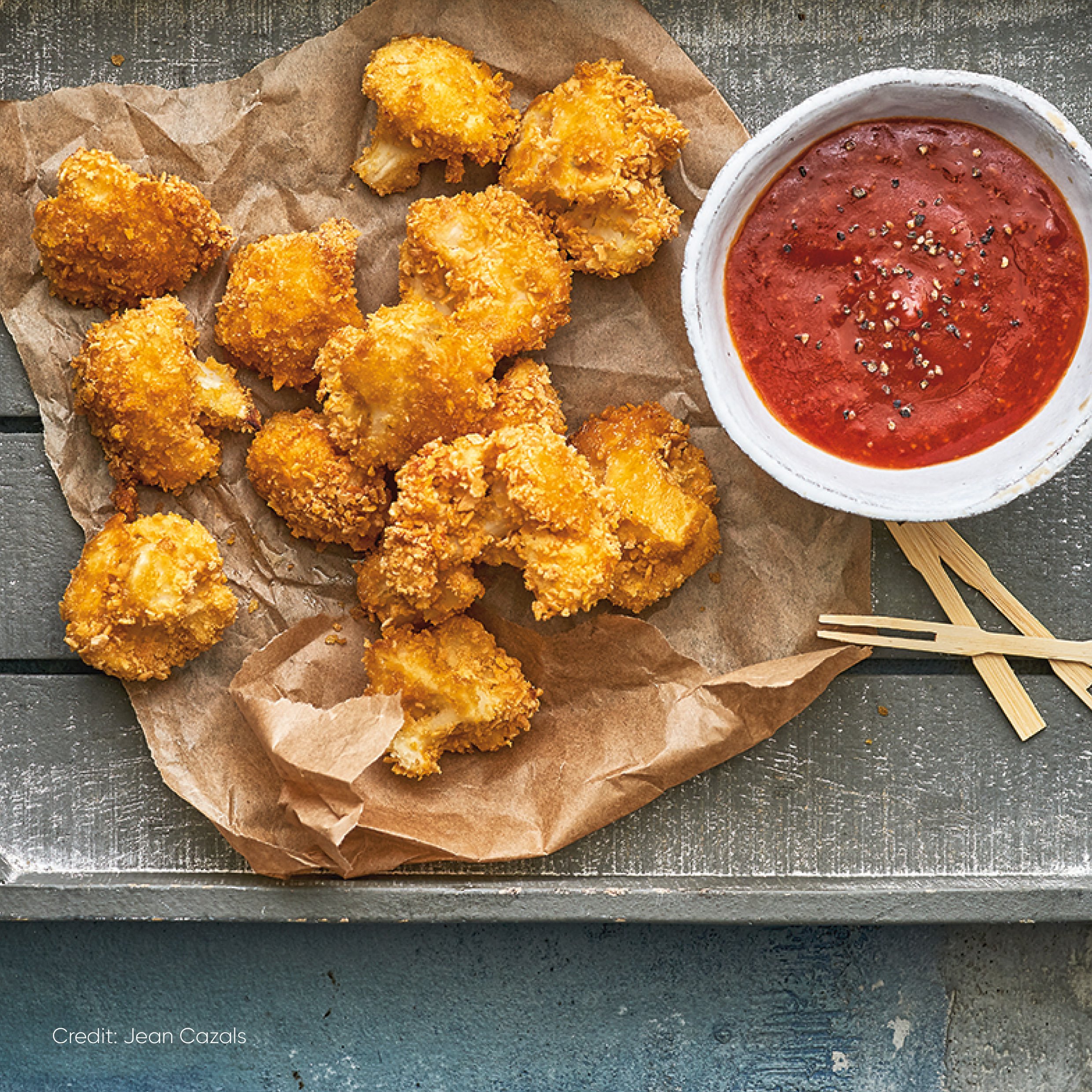Best In Season - November - written by Chef Consultant, Celia Brooks
Cauliflower Power
Cauliflower is indeed a flower. Actually, it’s an enormous cluster of flowers, in the bud stage, which grows from a tall and sturdy stem as thick as your wrist. It can take up to 1 cubic meter of space to grow one cauliflower, and some varieties take nearly a year to grow from seed to harvest. It’s hard to imagine how that’s economically viable for a cauliflower farmer, when they only cost loose change to buy.
Cauliflower’s value is immeasurable – it is one of the most versatile of all veg, speaking every language of flavouring, and adaptable to just about any method of preparation, from barbecuing to whizzing into raw couscous-like crumbs. To top it off, it’s abundantly nutritious, yet low in calories.
Whether larger than your head or smaller than your fist, cauliflowers usually come with some pale green, elegantly curvaceous leaves attached to the base. Everyone is accustomed or instructed to strip these off and discard them – but why? These are like a bonus vegetable that comes with the package! The leaves have a delicate cabbage flavour and can be treated any way you might use cabbage – steamed, stir-fried, added to soup, or shredded raw in a salad. If the leaves have thick stems, as long as they don’t seem too woody, chop and cook them up, along with the dense white core and stem of the cauliflower. It’s all good stuff.
This nutrient powerhouse vegetable is one of the best sources of indole-3-carbinol, which neutralises carcinogens, supports the immune system, and is important for oestrogen metabolism. It’s also a valuable source of multiple phytonutrients which are anti-cancer, anti-bacterial and anti-viral - these are present in all cruciferous vegetables. Eat cauliflower and live longer!
Here are just a few of my favourite simple ways with the mighty, versatile cauli:
Cauliflower couscous: This is a great low-cal and low-carb substitute for grains. Break the cauliflower into florets, wash and drain. Place in a food processor and whizz until reduced to crumbs the size of couscous. These can be eaten raw or cooked. To cook 250g, scrape into a microwave-safe container and sprinkle with salt, distributing it evenly with your fingertips. (No need to add water.) Cover and cook for 3 minutes, then stand for 2 minutes.
Cauliflower steaks: A sexy cross section of cooked cauliflower makes a fab alternative side veg, or a stand in for carbs. For one steak, cut a 2cm / 1 inch thick slab right from the middle of one cauliflower, cutting through the stem. Save the remainder for another use. You can cut more steaks, but they will be smaller and uneven sizes. Brush the steaks with oil and season with salt, then cook in a char-grill pan or roast in a 200C oven until tender. Or cook on a barbecue, turning regularly, until blackened in places and tender when prodded with a knife or skewer.
Roast florets: Cauliflower gets super sweet when roasted, and tastes heavenly when slightly charred. Toss raw florets with oil and salt, and whole spices such as cumin seeds if desired, then roast in a 200C oven until golden. Cook a few minutes more at 220C for charred edges.
Cauliflower Wings & Hot Sauce
From “SuperVeg” by Celia Brooks
One of America’s favourite junk food snack indulgences – Buffalo wings – can be morphed into a scrumptious, healthier alternative starring the mighty cauliflower. I can’t take credit for thinking of cauliflower in place of chicken wings – they are popping up on bar snack menus all over the place - but I’ve taken the idea and made it my own with a rather addictive cornflake crumb coating, which bakes to crisp perfection in the oven. They taste wicked but are actually angelic. These are perfect party fodder or great for slovenly munching in front of the TV. And they’re gluten-free and dairy-free, too.
Serves 2-4
Ingredients
cooking salt
250g cauliflower florets, about walnut size – 2-3 cm / 1 inch wide approx
100g cornflakes (opt for a natural, additive-free brand)
sea salt
2 eggs
coconut oil spray or other oil spray
For the sauce:
1 tablespoon coconut oil or extra virgin olive oil
4 tablespoons ketchup
½ tablespoon Sriracha or other hot chilli sauce, or to taste
2 teaspoons cider vinegar or rice vinegar
1 teaspoon light soy sauce
1 small garlic clove, crushed, or ½ teaspoon garlic powder
Method
1) Bring a pan of well-salted water to the boil. Add cauliflower and blanch for 1 minute, then remove and rinse under cold water until cool. Drain thoroughly.
2) Preheat the oven to 200C and line the baking tray. Whizz the cornflakes until they resemble very fine breadcrumbs. Place in a shallow bowl and stir through a good pinch of sea salt.
3) Beat the eggs in a small bowl. Dip each floret first in cornflakes, then in egg, then in cornflakes, until well coated and then place on the baking tray.
4) Spray each piece a few times with oil. Bake for 20 minutes, or until crisp and firm.
5) Meanwhile, make the hot sauce. Combine all ingredients in a small saucepan and gently bring to the boil, stirring frequently. Take off the heat, taste for seasoning and set aside.
6) Once the cauliflower florets are cooked, transfer the hot sauce to a dipping bowl and the florets to a sharing plate. Eat right away.



